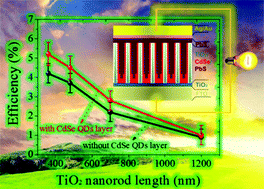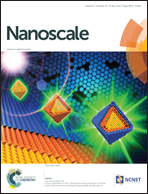A CdSe thin film: a versatile buffer layer for improving the performance of TiO2 nanorod array:PbS quantum dot solar cells†
Abstract
To fully utilize the multiple exciton generation effects in quantum dots and improve the overall efficiency of the corresponding photovoltaic devices, nanostructuralizing the electron conducting layer turns out to be a feasible strategy. Herein, PbS quantum dot solar cells were fabricated on the basis of morphologically optimized TiO2 nanorod arrays. By inserting a thin layer of CdSe quantum dots into the interface of TiO2 and PbS, a dramatic enhancement in the power conversion efficiency from 4.2% to 5.2% was realized and the resulting efficiency is one of the highest values for quantum dot solar cells based on nanostructuralized buffer layers. The constructed double heterojunction with a cascade type-II energy level alignment is beneficial for promoting photogenerated charge separation and reducing charge recombination, thereby responsible for the performance improvement, as revealed by steady-state analyses as well as ultra-fast photoluminescence and photovoltage decays. Thus this paper provides a good buffer layer to the community of quantum dot solar cells.



 Please wait while we load your content...
Please wait while we load your content...